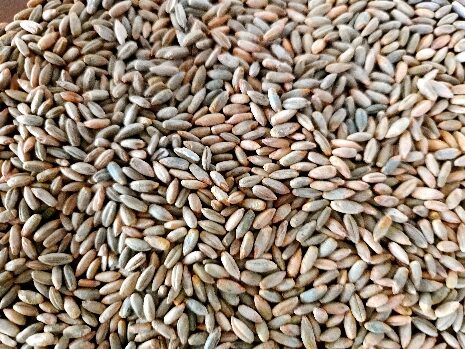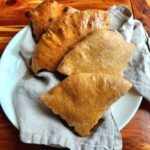Einkorn Sourdough Flatbread (Easy Oven Baked Recipe)

This sourdough flatbread recipe is easy to make, easy to digest, versatile, and filled with health benefits. It is made with simple ingredients using an ancient grain that is thousands of years old. If you are like me and love to make traditional foods, this is the bread recipe for you!
Flatbread Throughout History
- The earliest form of bread was flatbread. A recent discovery found at an archeological site in Jordan tells us that flatbread was made before people were farming grains! The ancient people in Jordan now called the Natufians gathered wild grains like einkorn wheat and barley, ground them up and combined them with tuber root vegetables to make dough.
- The first evidence of sourdough being used to leaven dough in bread making was by the Egyptians around 1500 BC using emmer wheat. The wheat varieties first known to be cultivated were einkorn and emmer wheat; barley was also cultivated around this time.
- Flatbreads were and are eaten around the world, with many cultures still making them in the traditional way out of a variety of grains and other ingredients. Chapati bread, naan bread, injera bread … kabkab, arepa, johnny cake, focaccia…these are just a few types of flatbreads from different countries! Traditional bread is very nutritious and has been an important part of many cultures’ diets throughout history.
Making Flatbread with Ancient Grains

Ancient wheat varieties have weaker forms of gluten compared to that of modern wheat, which can make it difficult to create a big round loaf of bread without it collapsing on itself. With flatbread being the first type of leavened bread, you can enjoy it the way it was made to be eaten – with easy to digest ancient grains!
The great thing about einkorn wheat is that it rises well with a wet dough. Flatbread can be made easily with a wet dough, so you end up with a delicious sourdough bread with a nutty flavor and a beautiful crumb! I haven’t tried this recipe yet with emmer or spelt flour, but I can’t wait to give it a try!
This Sourdough Flatbread Recipe is Versatile
- You can use this recipe to make pizza dough, focaccia bread, pita bread, or even sourdough crackers! I love simply having it freshly baked and dipped in a little olive oil side with herbs and sea salt.
- To make this recipe into pita bread, just make smaller flatbreads! Instead of 2 large flatbreads you can make 6 or 8 pita breads. The dough puffs up in the oven just like pita bread.
- To make this recipe into more of a thick focaccia type of flatbread, spread the dough into a greased 8x 8 inch pan (instead of using a preheated pizza pan) until about 1 inch thick and add desired toppings. Bake at 375 degrees F. for about 25-30 minutes.
- To make this recipe into pizza dough, press your dough on parchment paper into 1/4 centimeter circles instead of 1/4 inch ovals. Before adding your toppings like cheese and sauce, pre-bake the crust for about 5 minutes. After pre-baking, add your sauce and cheese and bake for about 5 more minutes or until cheese is golden brown.
- Making this recipe into sourdough crackers gives you a pita chip – like cracker. To make this recipe into pita chip crackers, press your dough on parchment paper into 1/4 centimeter rounds instead of 1/4 inch ovals and bake on a preheated pizza pan at 450 degrees F for 10 minutes. Take out your dough rounds and let cool for 10 minutes. Spread clarified butter or ghee on each side, and slice into triangles of your preferred size. Spread your triangles on a large stainless steel baking sheet, sprinkle with sea salt and bake at 450 degrees F for 3-5 minutes or until golden brown. Take out your sourdough pita chip crackers and let cool before enjoying to allow them to crisp up!
Easy and Convenient
- The flatbread dough in this recipe will be complete the same day having the dough rest at room temperature, so you don’t have to wait for this bread to proof in the refrigerator overnight!
- I find some stove-top cooked flatbread recipes to be a bit tedious. This recipe is easy because all you have to do to bake it is put it in the oven and take it out…no need to worry about flipping, brushing with melted butter, or burning anything in a hot pan.
- The best way to spread this dough is with your fingers, so you don’t need to use extra tools like a rolling pin.
- The best way to stretch and fold this wet dough is right in the mixing bowl, so you don’t have to dirty up extra counter space.
Tips and Tricks
- You can use a large cast-iron skillet, pizza stone, or cast iron pizza pan for baking. Make sure your pan is free of oil residue to prevent smoking up the house and setting off your fire alarm (I made this mistake…).
- Make sure to use parchment paper and NOT wax paper for spreading the dough and baking. Wax paper will burn and smoke at high temperatures (I have also made this mistake…).
- Make sure to use active sourdough starter; refresh your starter the night before or at least 4 hours prior to beginning your sourdough flatbread.
- When stretching and folding, put a little water on the hand that will be working the dough, and hold the bowl with the other hand. It makes stretching and folding way easier!
- When spreading the dough out into rounds with your fingers, add a little bit of extra flour on top if it begins to stick to your fingers.
- For the most nutrient dense and fresh tasting flatbreads, grind your own grains!
- Allow to cool completely before storing. For a softer bread, cover with a linen cloth or tea towel when cooling. Store in a sealed bag like a zip-lock bag or reusable silicone bag. At our house bread is usually gone within a couple of days so I often just store in on the counter-top, but you can also store it in the refrigerator for up to a week or the freezer for up to 4 months. Make sure to warm it up a bit in a toaster if over a day old for a nice texture!
How to Stretch and Fold Sourdough Dough
Stretching and folding is easy with this recipe. Wet one hand, and hold the bowl with the other hand. With the wet hand, pull a portion of dough on the outer edge as far as it will go without breaking, and push down toward the other side. Continue this process all the way around the dough round until it has decreased a fair amount in stretchiness. It usually takes about 10-15 times with this dough.
What to Serve With Einkorn Sourdough Flatbread

The options are endless… I love to have this flatbread with soups, olive oil dips, cottage cheese dips, hummus, baba ghanouj, and so many more dips. Because it puffs up and creates a pocket, it is the perfect thin bread to make a healthy sandwich or even a burger bun! If I’m craving something sweet I’ll melt chocolate chips and butter in the pocket.
Now let’s get baking!

Einkorn Sourdough Flatbread (Easy Oven Baked Recipe)
Equipment
- 1 Large nonmetallic bowl
- 1 Nonmetallic mixing utensil
- 1 Cast iron or stone pizza pan
- 2 Large sheets parchment paper
- 1 Kitchen Scale
Ingredients
- 1 cup active sourdough starter
- 300 grams filtered water
- 450 grams whole grain Einkorn flour (Preferably freshly ground. Can be substituted with other ancient grain like emmer or spelt by adding a little extra water.)
- 10 grams sea salt
- Extra virgin olive oil For dipping or drizzling over cooked flatbread
Instructions
- The night before or at least 4 hours prior to beginning bread making, refresh your sourdough starter.
- Add 1 cup of active sourdough starter to large nonmetallic bowl.
- Place the bowl with starter on a kitchen scale and tare to 0. Add 300 grams of filtered water and combine with nonmetallic mixing utensil.
- Tare scale to 0 with bowl on top. Add 450 grams of flour.
- Tare scale to 0 with bowl on top. Add 10 grams of sea salt.
- Remove bowl from scale and combine ingredients with nonmetallic mixing utensil. Dough will be rough looking.
- Cover bowl with large plate or lid and allow to rest for 20 minutes.
- Uncover bowl. Use 1 wet hand to stretch and fold the dough 10-15 times while holding and turning the bowl with the other hand. Cover bowl and let rest 20 minutes.
- Keeping dough in the bowl, repeat stretch and fold process 2 more times at 20 minute intervals. Dough will be fairly wet. The dough should be more flexible at each interval
- Cover with plate or lid and let proof 4-5 hours.
- Uncover bowl. Using a wet hand, stretch and fold dough in bowl to bring it together.
- Lay 2 large sheets of parchment paper out onto a flat surface and lightly dust each with flour. Separate the dough into two pieces with your hands and place one dough piece on each floured parchment paper sheet.
- Dust the top of each dough piece with flour and flour your hands. By pressing the dough with your fingers, spread each dough piece out into a large round or oval shape, until about 1/2 an inch thick. Add more flour as needed to prevent sticking to your fingers.
- Cover dough rounds with a linen cloth.
- Let proof for a final 60-90 minutes.
- Place stone or cast iron or pizza pan into oven and preheat to 475 °F
- Once oven is preheated, gently lift 1 dough round with parchment paper and place on pizza pan. Bake for 15 minutes.
- Remove flatbread and repeat with 2nd dough round.
- Allow flatbreads to cool for 10 minutes before serving.
- Optional: drizzle olive oil on top or make an olive oil and herb dip.






